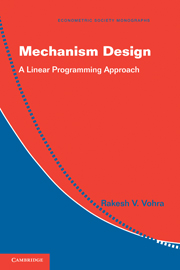2 - Arrow's Theorem and Its Consequences
Published online by Cambridge University Press: 05 January 2013
Summary
By custom and tradition, accounts of mechanism design begin with a genuflection in the direction of Kenneth Arrow and his (im)possibility theorem. The biblical Mas-Collel, Whinston, and Green (1995), for example, introduce mechanism design by reminding the reader of Arrow's theorem, introduced some chapters earlier. Weight of history aside, there is no logical reason for this. Not disposed to being bolshy, I bow to precedent and begin with an account of Arrow's theorem. Whereas the conceptual connection to mechanism design is tenuous, the mathematical connection, as the linear programming approach reveals, is remarkably close.
The environment considered involves a set Γ of alternatives (at least three). Let Σ denote the set of all strict preference orderings, that is, permutations over Γ. The set of admissible preference orderings or preference domain for a society of n-agents will be a subset of Σ and denoted Ω. Let Ωn be the set of all n-tuples of preferences from Ω, called profiles. An element of Ωn will typically be denoted as P = (p1, p2, …, pn), where pi is interpreted as the preference ordering of agent i.
The objective is to identify for each profile P a strict preference ordering that will summarize it – a “median” or “mean” preference ordering, if you will. The rule for summarizing a profile is called a social welfare function.
- Type
- Chapter
- Information
- Mechanism DesignA Linear Programming Approach, pp. 7 - 23Publisher: Cambridge University PressPrint publication year: 2011



